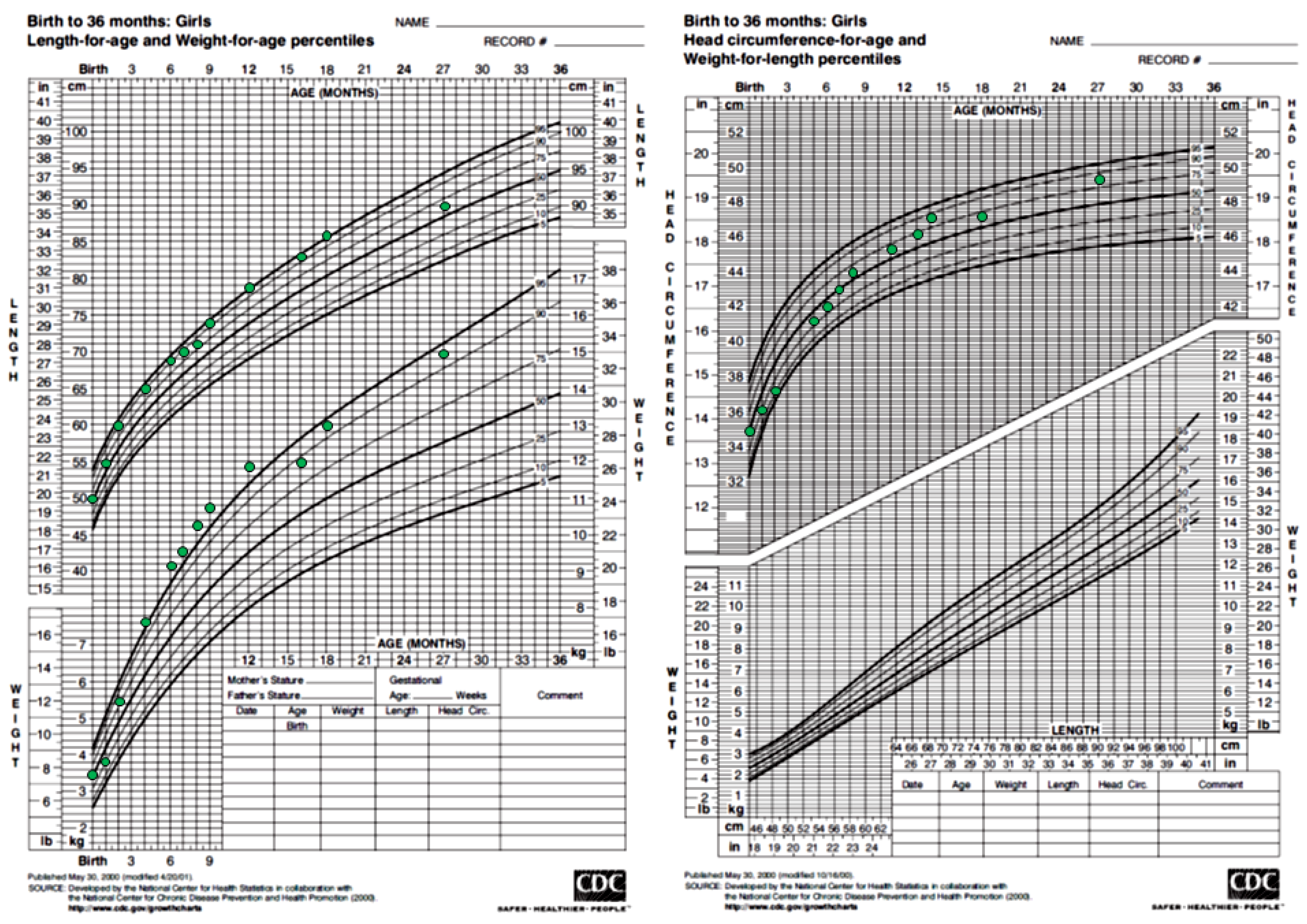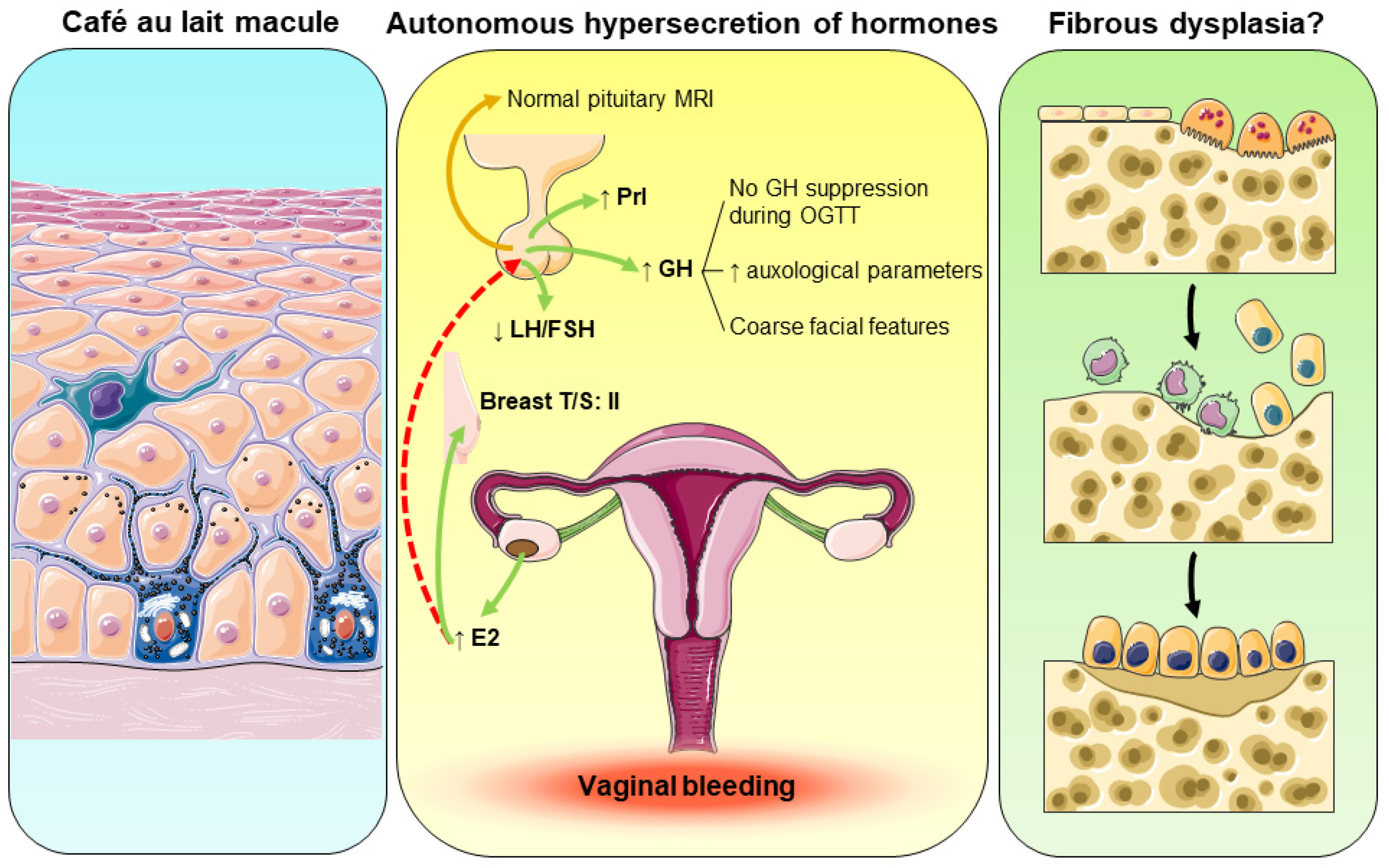McCune–Albright Syndrome: A Case Report and Review of Literature
Abstract
1. Introduction
2. Case Report
3. Discussion
4. Conclusions
Author Contributions
Funding
Institutional Review Board Statement
Informed Consent Statement
Data Availability Statement
Conflicts of Interest
References
- Spencer, T.; Pan, K.S.; Collins, M.T.; Boyce, A.M. The Clinical Spectrum of McCune-Albright Syndrome and Its Management. Horm. Res. Paediatr. 2019, 92, 347–356. [Google Scholar] [CrossRef] [PubMed]
- McCune, D.J. Osteitis fibrosa cystica; the case of a nine-year-old girl who also exhibits precocious puberty, multiple pigmentation of the skin and hyperthyroidism. Am. J. Dis. Child. 1936, 52, 743–744. [Google Scholar]
- Albright, F.; Butler, A.M.; Hampton, A.O.; Smith, P.H. Syndrome characterized by osteitis fibrosa disseminata, areas of pigmentation and endocrine dysfunction with precocious puberty in females, report of five cases. N. Engl. J. Med. 1937, 216, 727–746. [Google Scholar] [CrossRef]
- Lichtenstein, L.; Jaffe, H.L. Fibrous dysplasia of bone: A condition affecting one, several, or many bones, the graver cases of which may present abnormal pigmentation of skin, premature sexual development, hyperthyroidism or still other extra-skeletal abnormalities. Arch. Pathol. 1942, 33, 777–816. [Google Scholar]
- Diaz, A.; Danon, M.; Crawford, J. McCune-Albright syndrome and disorders due to activating mutations of GNAS1. J. Pediatr. Endocrinol. Metab. 2007, 20, 853–880. [Google Scholar] [CrossRef]
- Weinstein, L.S.; Shenker, A.; Gejman, P.V.; Merino, M.J.; Friedman, E.; Spiegel, A.M. Activating mutations of the stimulatory G protein in the McCune-Albright syndrome. N. Engl. J. Med. 1991, 325, 1688–1695. [Google Scholar] [CrossRef]
- Hopkins, C.; de Castro, L.F.; Corsi, A.; Boyce, A.; Collins, M.T.; Riminucci, M.; Heegaard, A.M. Fibrous dysplasia animal models: A systematic review. Bone 2022, 155, 116270. [Google Scholar] [CrossRef]
- Hartley, I.; Zhadina, M.; Collins, M.T.; Boyce, A.M. Fibrous dysplasia of bone and McCune-Albright syndrome: A bench to bedside review. Calcif. Tissue Int. 2019, 104, 517–529. [Google Scholar] [CrossRef]
- Fonin, A.V.; Darling, A.L.; Kuznetsova, I.M.; Turoverov, K.K.; Uversky, V.N. Multi-functionality of proteins ınvolved in GPCR and G protein signaling: Making sense of structure-function continuum with ıntrinsic disorder-based proteoforms. Cell Mol. Life Sci. CMLS 2019, 76, 4461–4492. [Google Scholar] [CrossRef]
- Coskuner-Weber, O.; Mirzanli, O.; Uversky, V.N. Intrinsically disordered proteins and proteins with intrinsically disordered regions in neurodegenerative diseases. Biophys. Rev. 2022, 14, 679–707. [Google Scholar] [CrossRef]
- Dumitrescu, C.E.; Collins, M.T. McCune-Albright syndrome. Orphanet. J. Rare Dis. 2008, 3, 12. [Google Scholar] [CrossRef] [PubMed]
- Boyce, A.M.; Collins, M.T. Fibrous Dysplasia/McCune-Albright Syndrome: A Rare, Mosaic Disease of Gα s Activation. Endocr. Rev. 2020, 41, 345–370. [Google Scholar] [CrossRef] [PubMed]
- Tufano, M.; Ciofi, D.; Amendolea, A.; Stagi, S. Auxological and Endocrinological Features in Children with McCune Albright Syndrome: A Review. Front. Endocrinol. 2020, 11, 522. [Google Scholar] [CrossRef] [PubMed]
- Riminucci, M.; Liu, B.; Corsi, A.; Shenker, A.; Spiegel, A.M.; Robey, P.G.; Bianco, P. The histopathology of fibrous dysplasia of bone in patients with activating mutations of the Gs alpha gene: Site-specific patterns and recurrent histological hallmarks. J. Pathol. 1999, 187, 249–258. [Google Scholar] [CrossRef]
- Robinson, C.; Collins, M.T.; Boyce, A.M. Fibrous dysplasia/McCune-Albright syndrome: Clinical and translational perspectives. Curr. Osteoporos. Rep. 2016, 14, 178–186. [Google Scholar] [CrossRef]
- Kushchayeva, Y.S.; Kushchayev, S.V.; Glushko, T.Y.; Tella, S.H.; Teytelboym, O.M.; Collins, M.T.; Boyce, A.M. Fibrous dysplasia for radiologists: Beyond ground glass bone matrix. Insights Imaging 2018, 9, 1035–1056. [Google Scholar] [CrossRef]
- de Castro, L.F.; Ovejero, D.; Boyce, A.M. Diagnosis of Endocrine Disease: Mosaic disorders of FGF23 excess: Fibrous dysplasia/McCune-Albright syndrome and cutaneous skeletal hypophosphatemia syndrome. Eur. J. Endocrinol. 2020, 182, R83–R99. [Google Scholar] [CrossRef]
- Riminucci, M.; Collins, M.T.; Fedarko, N.S.; Cherman, N.; Corsi, A.; White, K.E.; Waguespack, S.; Gupta, A.; Hannon, T.; Econs, M.J.; et al. FGF-23 in fibrous dysplasia of bone and its relationship to renal phosphate wasting. J. Clin. Investig. 2003, 112, 683–692. [Google Scholar] [CrossRef]
- Brillante, B.; Guthrie, L. McCune–Albright Syndrome. In Advanced Practice in Endocrinology Nursing; Llahana, S., Follin, C., Yedinak, C., Grossman, A., Eds.; Springer: Cham, Switzerland, 2019; pp. 207–228. [Google Scholar]
- Javaid, M.K.; Boyce, A.; Appelman-Dijkstra, N.; Ong, J.; Defabianis, P.; Offiah, A.; Arundel, P.; Shaw, N.; Pos, V.D.; Underhil, A.; et al. Best practice management guidelines for fibrous dysplasia/McCune-Albright syndrome: A consensus statement from the FD/MAS international consortium. Orphanet. J. Rare Dis. 2019, 14, 139. [Google Scholar] [CrossRef]
- Rotman, M.; Hamdy, N.A.T.; Appelman-Dijkstra, N.M. Clinical and translational pharmacological aspects of the management of fibrous dysplasia of bone. Br. J. Clin. Pharmacol. 2019, 85, 1169–1179. [Google Scholar] [CrossRef]
- Majoor, B.C.J.; Papapoulos, S.E.; Dijkstra, P.D.S.; Fiocco, M.; Hamdy, N.A.T.; Appelman-Dijkstra, N.M. Denosumab in Patients With Fibrous Dysplasia Previously Treated With Bisphosphonates. J. Clin. Endocrinol. Metab. 2019, 104, 6069–6078. [Google Scholar] [CrossRef] [PubMed]
- Collins, M.T.; de Castro, L.F.; Boyce, A.M. Denosumab for Fibrous Dysplasia: Promising, but Questions Remain. J. Clin. Endocrinol. Metab. 2020, 105, e4179–e4180. [Google Scholar] [CrossRef] [PubMed]
- Pan, K.S.; Boyce, A.M. Denosumab Treatment for Giant Cell Tumors, Aneurysmal Bone Cysts, and Fibrous Dysplasia-Risks and Benefits. Curr. Osteoporos. Rep. 2021, 19, 141–150. [Google Scholar] [CrossRef] [PubMed]
- Raborn, L.N.; Burke, A.B.; Ebb, D.H.; Collins, M.T.; Kaban, L.B.; Boyce, A.M. Denosumab for craniofacial fibrous dysplasia: Duration of efficacy and post-treatment effects. Osteoporos. Int. 2021, 32, 1889–1893. [Google Scholar] [CrossRef]
- Gladding, A.; Szymczuk, V.; Auble, B.A.; Boyce, A.M. Burosumab treatment for fibrous dysplasia. Bone 2021, 150, 116004. [Google Scholar] [CrossRef]
- Lee, J.S.; Fitz Gibbon, E.J.; Chen, Y.R.; Kim, H.J.; Lustig, L.R.; Akintoye, S.O.; Collins, M.T.; Kaban, L.B. Clinical guidelines for the management of craniofacial fibrous dysplasia. Orphanet. J. Rare Dis. 2012, 7 (Suppl. S1), S2. [Google Scholar] [CrossRef]
- Hart, E.S.; Kelly, M.H.; Brillante, B.; Chen, C.C.; Ziran, N.; Lee, J.S.; Feuillan, P.; Leet, A.I.; Kushner, H.; Robey, P.G.; et al. Onset progression and plateau of skeletal lesion in fibrous dysplasia and the relationship to functional outcome. J. Bone Miner. Res. 2007, 22, 1468–1474. [Google Scholar] [CrossRef]
- Boyce, A.M.; Florenzano, P.; de Castro, L.F.; Collins, M.T. Fibrous Dysplasia/McCune-Albright Syndrome. In Gene Reviews((R)); Adam, M.P., Mirzaa, G.M., Pagon, R.A., Wallace, S.E., Bean, L.J., Gripp, K.W., Amemiya, A., Eds.; University of Washington: Seattle, WA, USA, 1993. [Google Scholar]
- Lumbroso, S.; Paris, F.; Sultan, C.; European Collaborative Study. Activating Gs alpha mutations: Analysis of 113 patients with signs of McCune-Albright syndrome—A European Collaborative Study. J. Clin. Endocrinol. Metab. 2004, 89, 2107–2113. [Google Scholar] [CrossRef]
- Kalfa, N.; Philibert, P.; Audran, F.; Ecochard, A.; Hannon, T.; Lumbroso, S.; Sultan, C. Searching for somatic mutations in McCune-Albright syndrome: A comparative study of the peptidic nucleic acid versus the nested PCR method based on 148 DNA samples. Eur. J. Endocrinol. 2006, 155, 839–843. [Google Scholar] [CrossRef]
- Narumi, S.; Matsuo, K.; Ishii, T.; Tanahashi, Y.; Hasegawa, T. Quantitative and sensitive detection of GNAS mutations causing McCune-Albright syndrome with next generation sequencing. PLoS ONE 2013, 8, e60525. [Google Scholar] [CrossRef]
- de Sanctis, L.; Galliano, I.; Montanari, P.; Matarazzo, P.; Tessaris, D.; Bergallo, M. Combining Real-Time COLD- and MAMA-PCR TaqMan Techniques to Detect and Quantify R201 GNAS Mutations in the McCune-Albright Syndrome. Horm. Res. Paediatr. 2017, 87, 342–349. [Google Scholar] [CrossRef] [PubMed]
- Lo, F.S.; Chen, T.L.; Chiou, C.C. Detection of Rare Somatic GNAS Mutation in McCune-Albright Syndrome Using a Novel Peptide Nucleic Acid Probe in a Single Tube. Molecules 2017, 22, 1874. [Google Scholar] [CrossRef]
- Romanet, P.; Philibert, P.; Fina, F.; Cuny, T.; Roche, C.; Ouafik, L.; Paris, F.; Reynaud, R.; Barlier, A. Using Digital Droplet Polymerase Chain Reaction to Detect the Mosaic GNAS Mutations in Whole Blood DNA or Circulating Cell-Free DNA in Fibrous Dysplasia and McCune-Albright Syndrome. J. Pediatr. 2019, 205, 281–285.e4. [Google Scholar] [CrossRef]
- Elli, F.M.; de Sanctis, L.; Bergallo, M.; Maffini, M.A.; Pirelli, A.; Galliano, I.; Bordogna, P.; Arosio, M.; Mantovani, G. Improved Molecular Diagnosis of McCune-Albright Syndrome and Bone Fibrous Dysplasia by Digital PCR. Front. Genet. 2019, 10, 862. [Google Scholar] [CrossRef]
- Papanikolaou, A.; Michala, L. Autonomous Ovarian Cysts in Prepubertal Girls. How Aggressive Should We Be? A Review of the Literature. J. Pediatr. Adolesc. Gynecol. 2015, 28, 292–296. [Google Scholar] [CrossRef]
- Nabhan, Z.M.; West, K.W.; Eugster, E.A. Oophorectomy in McCune-Albright syndrome: A case of mistaken identity. J. Pediatr. Surg. 2007, 42, 1578–1583. [Google Scholar] [CrossRef] [PubMed]
- Gucev, Z.; Tasic, V.; Jancevska, A.; Krstevska-Konstantinova, M.; Pop-Jordanova, N. McCune-Albright syndrome (MAS): Early and extensive bone fibrous dysplasia involvement and “mistaken identity” oophorectomy. J. Pediatr. Endocrinol. Metab. 2010, 23, 837–842. [Google Scholar] [CrossRef] [PubMed]
- Zhai, X.; Duan, L.; Yao, Y.; Xing, B.; Deng, K.; Wang, L.; Feng, F.; Liang, Z.; You, H.; Yang, H.; et al. Clinical Characteristics and Management of Patients with McCune-Albright Syndrome with GH Excess and Precocious Puberty: A Case Series and Literature Review. Front. Endocrinol. 2021, 12, 672394. [Google Scholar] [CrossRef] [PubMed]


Disclaimer/Publisher’s Note: The statements, opinions and data contained in all publications are solely those of the individual author(s) and contributor(s) and not of MDPI and/or the editor(s). MDPI and/or the editor(s) disclaim responsibility for any injury to people or property resulting from any ideas, methods, instructions or products referred to in the content. |
© 2023 by the authors. Licensee MDPI, Basel, Switzerland. This article is an open access article distributed under the terms and conditions of the Creative Commons Attribution (CC BY) license (https://creativecommons.org/licenses/by/4.0/).
Share and Cite
Nicolaides, N.C.; Kontou, M.; Vasilakis, I.-A.; Binou, M.; Lykopoulou, E.; Kanaka-Gantenbein, C. McCune–Albright Syndrome: A Case Report and Review of Literature. Int. J. Mol. Sci. 2023, 24, 8464. https://doi.org/10.3390/ijms24108464
Nicolaides NC, Kontou M, Vasilakis I-A, Binou M, Lykopoulou E, Kanaka-Gantenbein C. McCune–Albright Syndrome: A Case Report and Review of Literature. International Journal of Molecular Sciences. 2023; 24(10):8464. https://doi.org/10.3390/ijms24108464
Chicago/Turabian StyleNicolaides, Nicolas C., Maria Kontou, Ioannis-Anargyros Vasilakis, Maria Binou, Evangelia Lykopoulou, and Christina Kanaka-Gantenbein. 2023. "McCune–Albright Syndrome: A Case Report and Review of Literature" International Journal of Molecular Sciences 24, no. 10: 8464. https://doi.org/10.3390/ijms24108464
APA StyleNicolaides, N. C., Kontou, M., Vasilakis, I.-A., Binou, M., Lykopoulou, E., & Kanaka-Gantenbein, C. (2023). McCune–Albright Syndrome: A Case Report and Review of Literature. International Journal of Molecular Sciences, 24(10), 8464. https://doi.org/10.3390/ijms24108464






